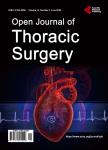Non-Invasive Pressure Support Ventilation in Major Lung Resection for High Risk Patients: Does It Matter?
非侵入性压力支持通气在主要肺切除术高危患者:有什么关系?作者机构:Department of Thoracic and Cardiovascular SurgeryUniversity Medical Centre GottingenGottingenGermany Department of PneumologyRespiratory Care and Sleep MedicineEvangelical Hospital WeendeGottingenGermany Department of Anaes-thesiologyEmergency and Intensive CareUniversity Medical Centre GöttingenGottingenGermany.
出 版 物:《Open Journal of Thoracic Surgery》 (胸外科期刊(英文))
年 卷 期:2012年第2卷第3期
页 面:63-71页
学科分类:1002[医学-临床医学] 100214[医学-肿瘤学] 10[医学]
主 题:Chronic Obstructive Lung Disease Clinical Trial Non-Invasive Positive-Pressure Ventilation Thoracic Surgery
摘 要:Background and purpose: Patients with severely impaired pulmonary function have an increased operative risk for major lung resection. The clinical benefits of pre- and perioperative, non-invasive pressure support ventilation (NIPSV) have up to now not been extensively evaluated. Patients with severely reduced pulmonary function were investigated in this prospective and randomised single centre clinical trial. Methods: Standard pulmonary evaluation was performed in all patients before major lung resection. To predict postoperative pulmonary function, a lung perfusion-ventilation scan was carried out. All patients enrolled in the study were instructed preoperatively on how to use a NIPSV respirator. Af-ter lung resection patients were randomised either for continuation of NIPSV or for standard treatment. Results: Of the 52 patients assessed, 21 patients met the inclusion criteria for the study protocol. Predicted mean postoperative FEV1 was 1.10 L (range 0.92 - 1.27 L). Lobectomy was performed in 14 patients, pneumonectomy in 6 patients and a segmentectomy in 1 patient. No inhospital deaths occurred. Pulmonary complications (reintubation, pneumonia) were more frequent in the NIPSV group than in the control group (3 patients versus 1 patient), without statistical significance (p = 0.31). Conclusions: We observed no mortality and a low morbidity in this high risk group. Postoperative continuation of NIPSV had no beneficial effect on the clinical outcome. Preoperative conditioning with NIPSV, however, seems to be a suitable tool for patients with severely impaired pulmonary function. This study may serve therefore as basis for further investigations for the potential clinical benefits of prophylactic NIPSV in major lung surgery.



